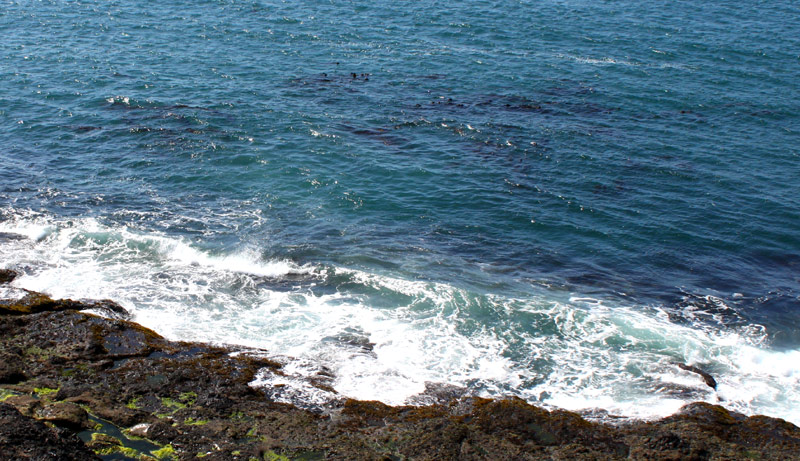One Sea Star Especially Linked to Die Off's of Kelp Forests: Oregon Coast Scientists
Published 03/01/023 at 4:52 AM
By Oregon Coast Beach Connection staff

Includes exclusive listings; some specials in winter
In Cannon Beach:
Includes rentals not listed anywhere else
In Manzanita, Wheeler, Rockaway Beach:
Some specials for winter
In Pacific City, Oceanside:
Some specials for winter
In Lincoln City:
Some specials for winter
In Depoe Bay, Gleneden Beach:
Some specials for winter
In Newport:
Look for some specials
In Waldport
Some specials for winter
In Yachats, Florence
Some specials for winter
Southern Oregon Coast Hotels / Lodgings
Reedsport to Brookings, places to stay; winter deals
(Newport, Oregon) – Just offshore from U.S. areas like the Oregon coast or Washington coast, there's a bit of an apocalypse brewing. That oft-smelly, kind of annoying debris on beaches known as kelp is actuality integral to the ecosystems along many coastal areas of the world, and it's being threatened. Kelp forests are shrinking around the globe, already stressed by marine heatwave events, and diminished further by a growing proliferation of urchins that eat them. (Photo above: kelp forest tops are the dark spot in this shot of Depoe Bay / copyright Oregon Coast Beach Connection)
A group of scientists from Oregon State University – including from the Oregon coast's Hatfield Marine Science Center – have discovered a direct link between the health of kelp forests off the world's coastlines and the gutting of sea star populations after a run of sea star wasting syndrome in the 2010s. The result is a struggling plant that is important to not only various species in these waters (and thus the fishing industry), but also to a vast economic sector that utilizes kelp in various products.
Sea star wasting syndrome took a toll on all sea stars along the western U.S., but one species was especially hit hard: the sunflower sea star. What began in 2013 has made for more than a 90% decline of that population around the planet, according to the OSU study. Since the sunflower sea star was one of the prime predators of sea urchins, their decimation has allowed the sea urchin to attack kelp forests and lay waste to some of them.
The study was a collaboration that also boasted scientists from the University of Oregon and The Nature Conservancy. Among them was Sarah Gravem, a research associate in the Oregon State College of Science.

Kelp on the beach, photo Seaside Aquarium
Gravem said the study's key finding was the link between the sunflower sea star (Pycnopodia helianthoides) and the health of kelp forests. Without the sea star, urchin populations go unchecked and create more issues for what scientists hope will be a kelp forest recovery.
That may have to wait. The study did come up with some directions for a recovery plan for sea stars, however – a step in the right direction. This included breeding programs.

Kelp is important to various fish by giving them a place to feed and hide from predators. The harvesting and use of kelp is an economic juggernaut estimated to be worth billions of dollars, used in products such as toothpaste, shampoos and even puddings and cakes.
The group estimated that as many as 5.75 billion of these animals died from the disease that still plagues the Oregon coast and Washington coast. In other parts of the world, such as Mexico, no sunflower sea stars have been spotted since 2016,.
”Only a handful have been found in Oregon and California since 2018,” Gravem said in a press release.

Photo Seaside Aquarium: back when the aquarium had sunflower sea stars, sunset would illuminate them in brilliant ways
“This study addresses that gap, and the findings are significant and somewhat surprising,” said principal investigator Aaron Galloway of the University of Oregon Institute of Marine Biology. “We found that these stars are eager consumers of purple urchins and, most importantly, they even eat the nutritionally poor, starving ‘zombie’ urchins.”
One of the issues with urchins is how resilient they are. They can live for years in a starved, emaciated state after they've devoured kelp forests. This makes it harder for kelp to come back, creating what are known as “barrens” - areas where kelp is gone and stays gone.
While one sunflower sea star only consume on average .68 urchins per day, when you multiply that by the billions that used to exist that is a healthy amount of ecosystem balance.
Oregon Coast Hotels in this area - South Coast Hotels - Where to eat - Maps - Virtual Tours
Cannon Beach Lodging
Nehalem Bay Lodgings
Manzanita Hotels, Lodging
Three Capes Lodging
Pacific City Hotels, Lodging
Lincoln City Lodging
Depoe Bay Lodging
Newport Lodging
Waldport Lodging
Yachats Lodging
Oregon Coast Vacation Rentals
Oregon Coast Lodging Specials
More About Oregon Coast hotels, lodging.....
More About Oregon Coast Restaurants, Dining.....
 Andre' GW Hagestedt is editor, owner and primary photographer / videographer of Oregon Coast Beach Connection, an online publication that sees over 1 million pageviews per month. He is also author of several books about the coast.
Andre' GW Hagestedt is editor, owner and primary photographer / videographer of Oregon Coast Beach Connection, an online publication that sees over 1 million pageviews per month. He is also author of several books about the coast.
LATEST Related Oregon Coast Articles
Wondrous Odd Science of Oregon Coast: Glowing, Singing, Flashing. Weather
Eclipse Weather for Oregon, Washington, Coastlines - How Clouds May Help Some...
Oregon and Washington will only get 23 percent or less of the sun. Weather, sciences
Oregon Coast / Washington Coast Answers: Those Strange, Snake-like Whips or T...
Bull kelp are a fun mystery on Northwest beaches. Marine sciences
Rockaway Beach Begins Improvement Program, Sprucing Up the N. Oregon Coast
Rockaway Beach has expanded its tourism grant program
ODOT: Little Humbug Bridge On Route to N. Oregon Coast Soon Under Constructio...
Near MP 8 on Hwy 26 to Seaside / Cannon Beach
Octopus Tree Atop Cape Meares: History, Hikes, Rumors of the Oregon Coast Celeb
Near Oceanside: how old, is it the tallest, shape, freaky facts, rumors
Herbert's 'Dune' Not All Sci-Fi: Real Science Behind Oregon Place That Inspir...
OSU has been researching here for decades; Dunes also in trouble. Florence, south Oregon coast
Razor Clamming Again Closes on Central Oregon Coast Due to Biotoxin
Closed from Cascade Head (just north of Lincoln City) to Seal Rock
Back to Oregon Coast
Contact Advertise on Oregon Coast Beach Connection
All Content, unless otherwise attributed, copyright Oregon Coast Beach Connection. Unauthorized use or publication is not permitted



















































